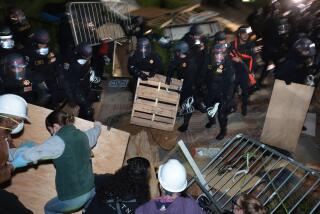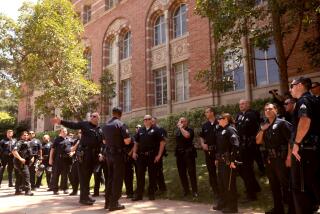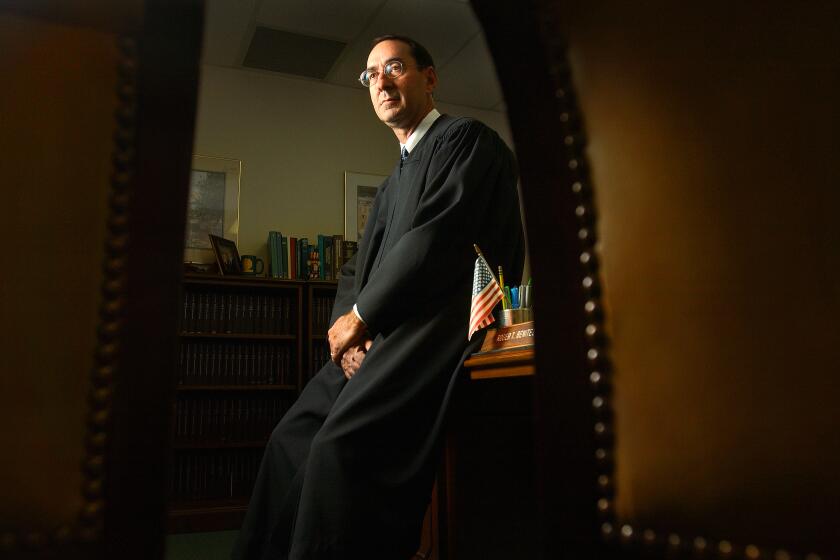FAA Approves LAX Modernization Plan
Federal officials signed off on the city’s $11-billion modernization plan for Los Angeles International Airport on Friday, allowing construction to start and forcing Mayor-elect Antonio Villaraigosa to make the issue a top priority.
Villaraigosa said he had spoken with U.S. Transportation Secretary Norman Mineta after the decision was announced and told him that he opposed some of the plan’s major components. Villaraigosa wants to eliminate a controversial passenger check-in center near the San Diego Freeway.
“He indicated that the decision was well on its way, and that they could not delay it because it was all ready to be issued,” Villaraigosa said of the conversation.
The Federal Aviation Administration must complete an environmental impact report and sign off on the city’s plan, but its decision Friday does not mean the city must follow the plan to the letter.
“This doesn’t require the city or the airport to take any action at all,” said Donn Walker, an FAA spokesman. “It simply means if they want to they can go ahead and implement” their airport plan.
The approval comes just three days after voters replaced the airport plan’s two strongest proponents -- Mayor James K. Hahn and Councilwoman Cindy Miscikowski -- with Villaraigosa and Bill Rosendahl, who oppose the proposal.
The FAA’s action will require Villaraigosa, who has not offered a comprehensive alternative blueprint, to make some tough decisions about LAX this summer. The city is currently spending about $2 million a month to design projects and to pay for legal costs. Some of the money is being spent on parts of the proposal that Villaraigosa opposes.
“I believe that we need to develop a regional approach to expanding capacity,” he said, adding that he thinks other airports should absorb some of the growth in passenger traffic.
On Friday, the airport-area’s congressional representatives also decried the FAA’s 58-page ruling.
“The only thing I can conclude is this may be an effort by someone to try to move the process forward faster and disregard the fact that we have a new councilman ... and a new mayor,” said Rep. Maxine Waters (D-Los Angeles).
Waters and Rep. Jane Harman (D-Venice), who both endorsed Villaraigosa, have repeatedly called on Los Angeles officials to revamp the plan, which was introduced by Hahn shortly after the Sept. 11, 2001, terrorist attacks. The plan is highly unpopular in airport-area communities. On Tuesday, Villaraigosa outpolled Hahn in most of these areas.
Officials hope to break ground on the first construction project, moving the southernmost runway 55 feet closer to El Segundo, next spring. The city must first hire a contractor, and the Airport Commission and the City Council must sign off on the project and its environmental documents.
Costs related to the plan are sure to mount as opponents file suit in the next 60 days to challenge the federal environmental impact report.When asked if her clients -- Inglewood, Culver City and Los Angeles County -- would sue in federal court, attorney Barbara Lichman said: “There’s no question about it.”
The city is currently facing litigation brought in state court by these entities and airport-area residents. The lawsuit alleges that the complex environmental studies for the LAX plan understate the effects of noise, air pollution and traffic. A hearing is scheduled in August.
How Villaraigosa chooses to fix LAX could have wide-ranging implications for his administration. Reworking the city’s aging airport, which was used by about 60 million travelers last year, has proven to be problematic for both Hahn and his predecessor, Richard J. Riordan. The city has spent $147 million in the last 10 years trying to rework the world’s fifth-busiest airport, which consistently ranks near the bottom in surveys of traveler satisfaction.
Riordan left office before his expansion plan was approved. Hahn’s plan faced certain defeat in the City Council last year before Miscikowski -- who currently represents the airport area -- suggested splitting the plan’s projects into two phases.
The first phase features the most popular elements, including a transit hub near the Century Freeway, a consolidated rental car center in parking lot C and a people mover.
More controversial components, including a check-in center in a Westchester neighborhood, the demolition of terminals 1, 2 and 3 and the building of a terminal in the middle of the airport’s horseshoe-shaped roadway, are part of a second phase. These so-called “yellow-light” projects require additional traffic, environmental and safety reviews before they could be built.
Hahn lauded the FAA’s decision Friday.
“I am pleased,” he said in a statement, “and look forward to working with labor, businesses, public safety officials and other stakeholders throughout the city as we continue to make LAX a model for safety, security and passenger convenience.”
But the mayor is unlikely to see any actual progress on his plan before he leaves office.
Villaraigosa is likely to make a decision about LAX in conjunction with Rosendahl, a former local television host who won Miscikowski’s seat. Rosendahl said Friday that he would “expect a reconsideration and another opportunity to weigh in on the issue.”
“The mayor-elect ... and I will talk a little bit more about our common strategy,” he said.
Community leaders and legal experts questioned whether Rosendahl would be able to request another council vote on Hahn’s LAX plan.
“I think it’s a hard thing to do to have council members go back on a vote so shortly after their original vote,” said Brendan Huffman, director of public policy at the Los Angeles Area Chamber of Commerce.
Legal experts said that Villaraigosa could order the Airport Commission to start the whole process over. But he has said that he wanted the first phase of Hahn’s plan to move forward.
Complicating the matter is Villaraigosa’s assertion that he would kill the proposal’s most controversial projects. Attorneys for the city and opponents argue that removing the second phase would invalidate the plan’s environmental analysis. The new mayor also would have to grapple with how to hold capacity at LAX to 78 million passengers. The plan to do that, by removing 10 gates for airplanes, is part of the second phase.
If he does away with that phase, Villaraigosa would also jeopardize part of a $500-million agreement tied to Hahn’s plan that is designed to ease noise, air pollution and traffic and provide jobs to residents living near LAX.
Architects of this deal said Friday that the community benefits were linked to individual projects and that schools near the airport would probably lose a large portion of funding if the controversial projects were cut.
“If the yellow-light projects are scaled back, then the benefits tied to those projects would be scaled back or eliminated,” said Danny Tabor, a former Inglewood city councilman. He said the coalition that negotiated with airport officials to reach a community-benefits agreement was hoping to meet with Villaraigosa soon.
“We really need to show him how it all fits together so he has a clear understanding of the various aspects of the master plan.”
Other airport-area residents also hope to get the mayor-elect’s ear, saying they will withdraw litigation if he agrees to a proposal they plan to release next week. The document will ask for a security study of the plan, a limit on passenger growth and an increase in landing fees as an incentive for airlines to fly the new 550-seat Airbus A380, the largest airliner ever built, to city-owned airports in Ontario and Palmdale.
“They could have variable landing fees ... that would make alternative airports much more attractive,” said Jan Chatten-Brown, an attorney who represents airport-area residents. “There are other airports in the Greater Los Angeles area that have the capacity to take up the burden, and a lot of these communities want these flights.”
*
(BEGIN TEXT OF INFOBOX)
Approaching take-off
The two-phase, $11-billion remodeling of Los Angeles International Airport could start next year and would take at least 10 years to complete.
First phase
International terminal: $683 million
Add gates to west side of Tom Bradley terminal
People mover: $557 million
Construct elevated people mover to connect new transit center, rental car center and existing terminals
Rental car center: $476 million
Consolidate most rental car companies at one site
Intermodal transit center: $293 million
Connect bus routes and Green Line with people mover; add 9,100 parking spaces
West employee parking: $268 million
Build 12,400-space structure
South airfield: $255 million
Rebuild southernmost runway 55 feet farther south and construct center taxiway for added safety
Roads and communications: $230 million
Improve streets and add new communications network
South terminals: $125 million
Modernize southern terminals
Southeast surface parking: $32 million
Add 5,470 long-term parking spaces
Total: $2.9 billion
--
Second phase
Central terminal area: $2.22 billion
After demolishing parking structures,build a new terminal on the site
Satellite terminal: $1.78 billion
Add new concourse to handle larger aircraft, with connections to people mover and baggage system
North airfield: $1.247 billion
Rebuild parallel runways to handle larger aircraft and construct center taxiway for added safety
Central check-in facility: $1.18 billion
Build check-in center with people mover stations, 7,495 parking spaces and a baggage tunnel to terminals
North concourse: $850 million
Build new north concourse.
People mover: $557 million
Link the check-in center with the terminals
Communications and roads: $143 million
Complete communications network; improve roads
Fuel farm: $56 million
Reconfigure fuel farm to accommodate new taxiways
Total: $8.0 billion
Source: Los Angeles World Airports
More to Read
Start your day right
Sign up for Essential California for news, features and recommendations from the L.A. Times and beyond in your inbox six days a week.
You may occasionally receive promotional content from the Los Angeles Times.






